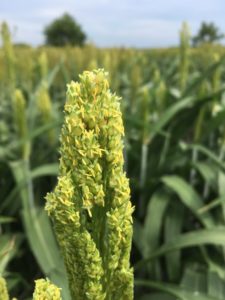Sorghum fields across the Mid-Coast of Texas are beginning to bloom. These fields are susceptible to sorghum midge damage.
The sorghum midge is one of the most damaging insects of sorghum in Texas, especially in the southern half of the state. The adult sorghum midge is a small, fragile-looking orange-red fly with a yellow head, brown antennae and legs and gray, membranous wings.
During the single day of adult life, each female lays about 50 yellowish-white eggs in flowering spikelets of sorghum. Eggs hatch in 2 to 3 days. Larvae are colorless at first, but when fully grown, are dark orange. Larvae complete development in 9 to 11 days and pupate between the spikelet glumes. Shortly before adult emergence, the pupa works its way toward the upper tip of the spikelet. After the adult emerges, the clear or white pupal skin remains at the tip of the spikelet.
A generation is completed in 14 to 16 days under favorable conditions. Sorghum midge numbers increase rapidly because of multiple generations during a season and when sorghum flowering times are extended by a range of planting dates or sorghum maturities.
A sorghum midge damages sorghum when the larva feeds on a newly fertilized ovary, preventing normal kernel development.
Sorghum midge lay eggs in spikelets when yellow anthers are visible on the sorghum head. An individual grain head requires 7-9 days to complete flowering while 2-3 weeks may be required for all the heads to flower within a field. Thus, a field can remain susceptible to midge infestation for several weeks, depending on how uniformly the plants flower. Once anthers turn reddish-brown they are no longer susceptible to midge infestation.
Begin scouting for midge soon after head emergence when yellow blooms first appear in the field. Scout for sorghum midge at mid-morning when the temperature warms to approximately 85 degrees F. The adult lives for only a day, and each day a new brood of adults emerges. For this reason, flowering fields should be sampled almost daily.
Sorghum midge can be monitored by inspecting carefully and at close range all sides of randomly selected flowering grain heads. Look for the reddish, gnat-like adults crawling on or flying about flowering heads. Handle grain heads carefully during inspection to avoid disturbing adult sorghum midges. Another sampling method is to gently but quickly slip a one-gallon clear plastic bag over the head and tap the head to disturb midge which will fly up in the bag where they can be easily seen and counted. A more rapid yet still efficient method is to turn the head downward into a white plastic bucket or pail and beat the head in the bucket to knock the midge from the head. Remove the head and count any sorghum midge in the pail or bucket. A one-gallon milk jug with the bottom cut out also works well for this type of sampling.
Because they are relatively weak fliers and rely on wind currents to aid their dispersal, adult sorghum midges usually are most abundant along edges of sorghum fields. For this reason, inspect plants along field borders first, particularly those downwind of earlier flowering sorghum or Johnsongrass. If no or few sorghum midges are found on sorghum grain heads along field edges, there should be little need to sample the entire field.
However, if you find more than one sorghum midge per flowering grain head in border areas of a sorghum field, inspect the rest of the field. Sample at least 20 flowering grain heads for every 20 acres in a field. For fields smaller than 20 acres, sample 40 flowering grain heads.
An Economic Threshold for Sorghum Midge can be found using the Sorghum Midge Calculator. My current threshold is 0.5 to 2 midge per head depending on the number of blooming heads per acre. Be sure and include application cost ($3-7/acre) when calculating the cost of control per acre.
This and more information is available in the Extension Publicaiton “Managing Insect and Mite Pests of Texas Sorghum, B-1220“

